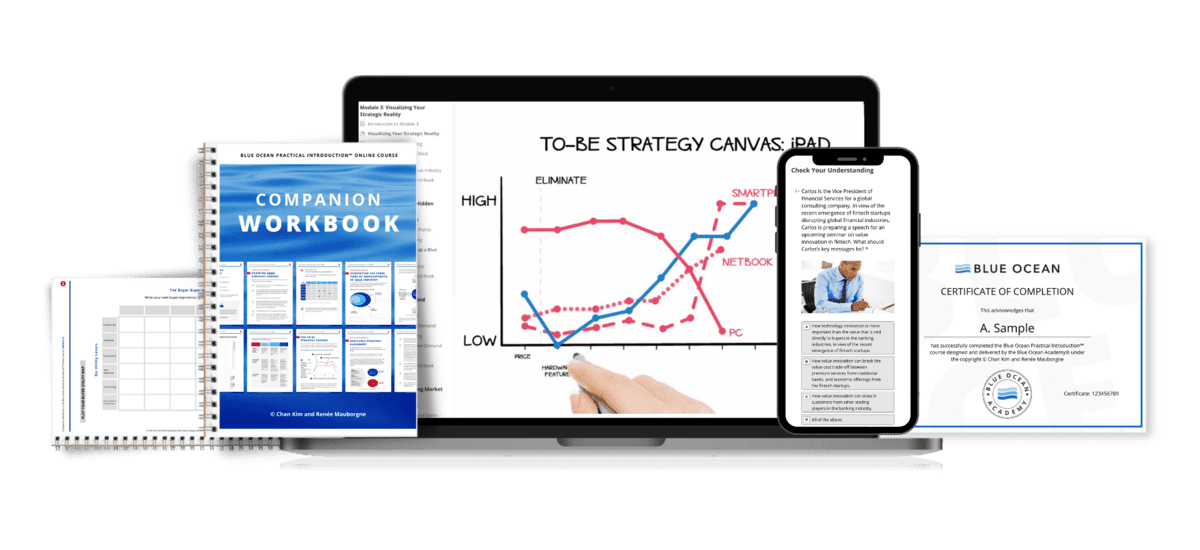BLOOMBERG
In a little more than a decade, the U.S.-based financial information provider, Bloomberg became one of the largest and most profitable business information providers in the world. Challenging its industry’s conventional wisdom about which buyer group to target, Bloomberg created a blue ocean in the financial information services industry.
Until Bloomberg’s debut in the early 1980s, Reuters, Dow Jones and Telerate dominated the online financial information industry, providing news and prices in real time to the brokerage and investment community. The industry focused on purchasers —IT managers—who valued standardized systems, which made their lives easier.
Bloomberg saw that it was traders and analysts, not IT managers, who make or lose millions of dollars for their employers each day. Profit opportunities come from disparities in information. When markets are active, traders and analysts must make rapid decisions. Every second counts.
So Bloomberg designed a system specifically to offer traders a leap in value, one with easy-to-use terminals and keyboards labeled with familiar financial terms. The systems also have two flat-panel monitors so that traders can see all the information they need at once and built-in analytic capability with the press of a button.
By focusing on users, Bloomberg was able to create a blue ocean of strong and profitable growth. With this shift in focus Bloomberg could also see the paradox of traders’ and analysts’ personal lives. They have tremendous income but work such long hours that they have little time to spend it. Realizing that markets have slow times during the day when little trading takes place, Bloomberg decided to add information and purchasing services aimed at enhancing traders’ personal lives. Well before the internet offered such services, traders could use Bloomberg online services to buy items such as flowers, clothing, and jewelry; make travel arrangements; get information about wines; or search through real estate listings.
By shifting its focus upstream from purchasers to users, Bloomberg created a value curve that was radically different from anything the industry had seen before. The traders and analysts wielded their power within their firms to force IT managers to purchase Bloomberg terminals. This is an example of path three of blue ocean strategy’s six paths framework that suggests that companies can gain new insights into unlocking blue oceans by looking across the chain of buyers in an industry and shifting their focus to a previously overlooked set of buyers.
BLOOMBERG
In a little more than a decade, the U.S.-based financial information provider, Bloomberg became one of the largest and most profitable business information providers in the world. Challenging its industry’s conventional wisdom about which buyer group to target, Bloomberg created a blue ocean in the financial information services industry.
Until Bloomberg’s debut in the early 1980s, Reuters, Dow Jones and Telerate dominated the online financial information industry, providing news and prices in real time to the brokerage and investment community. The industry focused on purchasers —IT managers—who valued standardized systems, which made their lives easier.
Bloomberg saw that it was traders and analysts, not IT managers, who make or lose millions of dollars for their employers each day. Profit opportunities come from disparities in information. When markets are active, traders and analysts must make rapid decisions. Every second counts.
So Bloomberg designed a system specifically to offer traders a leap in value, one with easy-to-use terminals and keyboards labeled with familiar financial terms. The systems also have two flat-panel monitors so that traders can see all the information they need at once and built-in analytic capability with the press of a button.
By focusing on users, Bloomberg was able to create a blue ocean of strong and profitable growth. With this shift in focus Bloomberg could also see the paradox of traders’ and analysts’ personal lives. They have tremendous income but work such long hours that they have little time to spend it. Realizing that markets have slow times during the day when little trading takes place, Bloomberg decided to add information and purchasing services aimed at enhancing traders’ personal lives. Well before the internet offered such services, traders could use Bloomberg online services to buy items such as flowers, clothing, and jewelry; make travel arrangements; get information about wines; or search through real estate listings.
By shifting its focus upstream from purchasers to users, Bloomberg created a value curve that was radically different from anything the industry had seen before. The traders and analysts wielded their power within their firms to force IT managers to purchase Bloomberg terminals. This is an example of path three of blue ocean strategy’s six paths framework that suggests that companies can gain new insights into unlocking blue oceans by looking across the chain of buyers in an industry and shifting their focus to a previously overlooked set of buyers.
THE BLUE OCEAN STRATEGY PRACTITIONER PROGRAM

Transform your strategic perspective, master blue ocean tools and frameworks, & learn to unlock new growth opportunities
Get started with new market creation with our live, interactive, expert-led program.


















